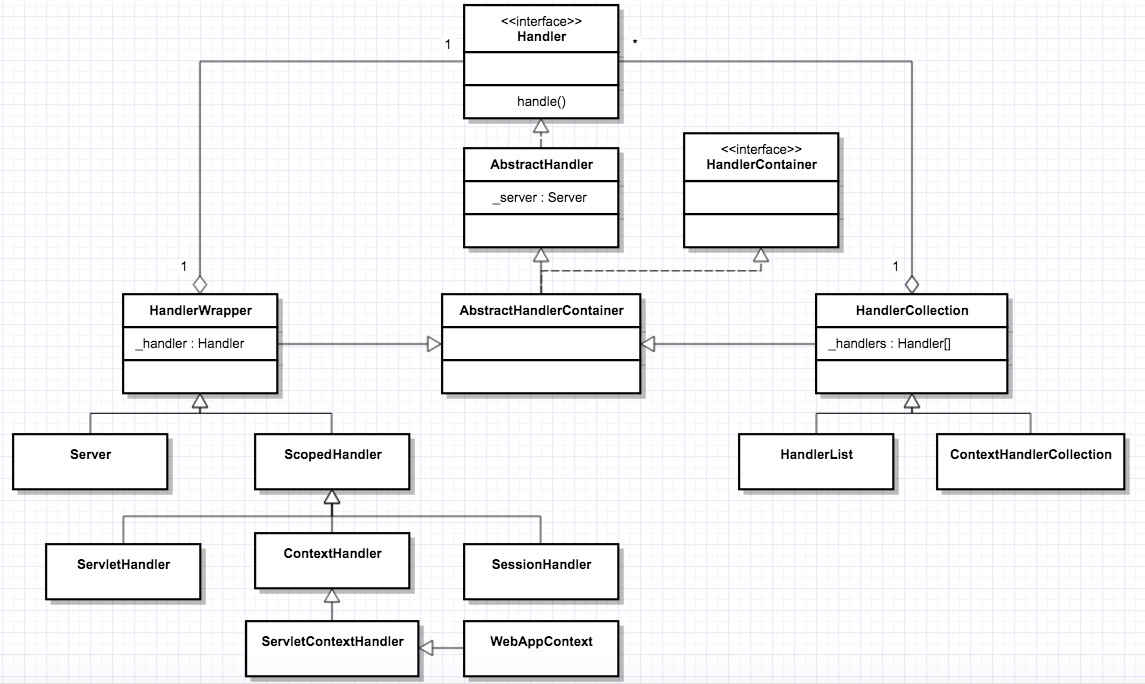29 | 比较:Jetty如何实现具有上下文信息的责任链?

讲述:李号双
时长09:59大小9.15M
我们知道 Tomcat 和 Jetty 的核心功能是处理请求,并且请求的处理者不止一个,因此 Tomcat 和 Jetty 都实现了责任链模式,其中 Tomcat 是通过 Pipeline-Valve 来实现的,而 Jetty 是通过 HandlerWrapper 来实现的。HandlerWrapper 中保存了下一个 Handler 的引用,将各 Handler 组成一个链表,像下面这样:
WebAppContext -> SessionHandler -> SecurityHandler -> ServletHandler
这样链中的 Handler 从头到尾能被依次调用,除此之外,Jetty 还实现了“回溯”的链式调用,那就是从头到尾依次链式调用 Handler 的方法 A,完成后再回到头节点,再进行一次链式调用,只不过这一次调用另一个方法 B。你可能会问,一次链式调用不就够了吗,为什么还要回过头再调一次呢?这是因为一次请求到达时,Jetty 需要先调用各 Handler 的初始化方法,之后再调用各 Handler 的请求处理方法,并且初始化必须在请求处理之前完成。
而 Jetty 是通过 ScopedHandler 来做到这一点的,那 ScopedHandler 跟 HandlerWrapper 有什么关系呢?ScopedHandler 是 HandlerWrapper 的子类,我们还是通过一张图来回顾一下各种 Handler 的继承关系:
从图上我们看到,ScopedHandler 是 Jetty 非常核心的一个 Handler,跟 Servlet 规范相关的 Handler,比如 ContextHandler、SessionHandler、ServletHandler、WebappContext 等都直接或间接地继承了 ScopedHandler。
今天我就分析一下 ScopedHandler 是如何实现“回溯”的链式调用的。
HandlerWrapper
为了方便理解,我们先来回顾一下 HandlerWrapper 的源码:
从代码可以看到它持有下一个 Handler 的引用,并且会在 handle 方法里调用下一个 Handler。
ScopedHandler
ScopedHandler 的父类是 HandlerWrapper,ScopedHandler 重写了 handle 方法,在 HandlerWrapper 的 handle 方法的基础上引入了 doScope 方法。
上面的代码中是根据_outerScope是否为 null 来判断是使用 doScope 还是 doHandle 方法。那_outScope又是什么呢?_outScope是 ScopedHandler 引入的一个辅助变量,此外还有一个_nextScope变量。
我们看到__outerScope是一个 ThreadLocal 变量,ThreadLocal 表示线程的私有数据,跟特定线程绑定。需要注意的是__outerScope实际上保存了一个 ScopedHandler。
下面通过我通过一个例子来说明_outScope和_nextScope的含义。我们知道 ScopedHandler 继承自 HandlerWrapper,所以也是可以形成 Handler 链的,Jetty 的源码注释中给出了下面这样一个例子:
经过上面的设置之后,形成的 Handler 链是这样的:
上面的过程只是设置了_handler变量,那_outScope和_nextScope需要设置成什么样呢?为了方便你理解,我们先来看最后的效果图:
从上图我们看到:scopedA 的_nextScope=scopedB,scopedB 的_nextScope=scopedC,为什么 scopedB 的_nextScope不是 WrapperX 呢,因为 WrapperX 不是一个 ScopedHandler。scopedC 的_nextScope是 null(因为它是链尾,没有下一个节点)。因此我们得出一个结论:_nextScope指向下一个 Scoped 节点的引用,由于 WrapperX 不是 Scoped 节点,它没有_outScope和_nextScope变量。
注意到 scopedA 的_outerScope是 null,scopedB 和 scopedC 的_outScope都是指向 scopedA,即_outScope指向的是当前 Handler 链的头节点,头节点本身_outScope为 null。
弄清楚了_outScope和_nextScope的含义,下一个问题就是对于一个 ScopedHandler 对象如何设置这两个值以及在何时设置这两个值。答案是在组件启动的时候,下面是 ScopedHandler 中的 doStart 方法源码:
你可能会问,为什么要设计这样一个全局的__outerScope,这是因为这个变量不能通过方法参数在 Handler 链中进行传递,但是在形成链的过程中又需要用到它。
你可以想象,当 scopedA 调用 start 方法时,会把自己填充到__scopeHandler中,接着 scopedA 调用super.doStart。由于 scopedA 是一个 HandlerWrapper 类型,并且它持有的_handler引用指向的是 scopedB,所以super.doStart实际上会调用 scopedB 的 start 方法。
这个方法里同样会执行 scopedB 的 doStart 方法,不过这次__outerScope.get方法返回的不是 null 而是 scopedA 的引用,所以 scopedB 的_outScope被设置为 scopedA。
接着super.dostart会进入到 scopedC,也会将 scopedC 的_outScope指向 scopedA。到了 scopedC 执行 doStart 方法时,它的_handler属性为 null(因为它是 Handler 链的最后一个),所以它的super.doStart会直接返回。接着继续执行 scopedC 的 doStart 方法的下一行代码:
对于 HandlerWrapper 来说 getChildHandlerByClass 返回的就是其包装的_handler对象,这里返回的就是 null。所以 scopedC 的_nextScope为 null,这段方法结束返回后继续执行 scopedB 中的 doStart 中,同样执行这句代码:
因为 scopedB 的_handler引用指向的是 scopedC,所以 getChildHandlerByClass 返回的结果就是 scopedC 的引用,即 scopedB 的_nextScope指向 scopedC。
同理 scopedA 的_nextScope会指向 scopedB。scopedA 的 doStart 方法返回之后,其_outScope为 null。请注意执行到这里只有 scopedA 的_outScope为 null,所以 doStart 中 finally 部分的逻辑被触发,这个线程的 ThreadLocal 变量又被设置为 null。
你可能会问,费这么大劲设置_outScope和_nextScope的值到底有什么用?如果你觉得上面的过程比较复杂,可以跳过这个过程,直接通过图来理解_outScope和_nextScope的值,而这样设置的目的是用来控制 doScope 方法和 doHandle 方法的调用顺序。
实际上在 ScopedHandler 中对于 doScope 和 doHandle 方法是没有具体实现的,但是提供了 nextHandle 和 nextScope 两个方法,下面是它们的源码:
从 nextHandle 和 nextScope 方法大致上可以猜到 doScope 和 doHandle 的调用流程。我通过一个调用栈来帮助你理解:
因此通过设置_outScope和_nextScope的值,并且在代码中判断这些值并采取相应的动作,目的就是让 ScopedHandler 链上的doScope 方法在 doHandle、handle 方法之前执行。并且不同 ScopedHandler 的 doScope 都是按照它在链上的先后顺序执行的,doHandle 和 handle 方法也是如此。
这样 ScopedHandler 帮我们把调用框架搭好了,它的子类只需要实现 doScope 和 doHandle 方法。比如在 doScope 方法里做一些初始化工作,在 doHanlde 方法处理请求。
ContextHandler
接下来我们来看看 ScopedHandler 的子类 ContextHandler 是如何实现 doScope 和 doHandle 方法的。ContextHandler 可以理解为 Tomcat 中的 Context 组件,对应一个 Web 应用,它的功能是给 Servlet 的执行维护一个上下文环境,并且将请求转发到相应的 Servlet。那什么是 Servlet 执行的上下文?我们通过 ContextHandler 的构造函数来了解一下:
我们看到 ContextHandler 维护了 ServletContext 和 Web 应用的初始化参数。那 ContextHandler 的 doScope 方法做了些什么呢?我们看看它的关键代码:
从代码我们看到在 doScope 方法里主要是做了一些请求的修正、类加载器的设置,并调用 nextScope,请你注意 nextScope 调用是由父类 ScopedHandler 实现的。接着我们来 ContextHandler 的 doHandle 方法:
从上面的代码我们看到 ContextHandler 在 doHandle 方法里分别完成了相应的请求处理工作。
本期精华
今天我们分析了 Jetty 中 ScopedHandler 的实现原理,剖析了如何实现链式调用的“回溯”。主要是确定了 doScope 和 doHandle 的调用顺序,doScope 依次调用完以后,再依次调用 doHandle,它的子类比如 ContextHandler 只需要实现 doScope 和 doHandle 方法,而不需要关心它们被调用的顺序。
这背后的原理是,ScopedHandler 通过递归的方式来设置_outScope和_nextScope两个变量,然后通过判断这些值来控制调用的顺序。递归是计算机编程的一个重要的概念,在各种面试题中也经常出现,如果你能读懂 Jetty 中的这部分代码,毫无疑问你已经掌握了递归的精髓。
另外我们进行层层递归调用中需要用到一些变量,比如 ScopedHandler 中的__outerScope,它保存了 Handler 链中的头节点,但是它不是递归方法的参数,那参数怎么传递过去呢?一种可能的办法是设置一个全局变量,各 Handler 都能访问到这个变量。但这样会有线程安全的问题,因此 ScopedHandler 通过线程私有数据 ThreadLocal 来保存变量,这样既达到了传递变量的目的,又没有线程安全的问题。
课后思考
ScopedHandler 的 doStart 方法,最后一步是将线程私有变量__outerScope设置成 null,为什么需要这样做呢?
不知道今天的内容你消化得如何?如果还有疑问,请大胆的在留言区提问,也欢迎你把你的课后思考和心得记录下来,与我和其他同学一起讨论。如果你觉得今天有所收获,欢迎你把它分享给你的朋友。
精选留言(3)
- nightmare2019-07-16每一次请求的请求链互不影响展开 2
- despacito2019-07-16ScopedHandler 会有不同的实现类,而__outerScope 是ScopedHandler里static的变量,如果不设置为null,那么不同的子类实例执行doStrat()方法的时候,会有问题 1
- 往事随风,顺其自然2019-07-16可以重新处理下一次请求展开 1



